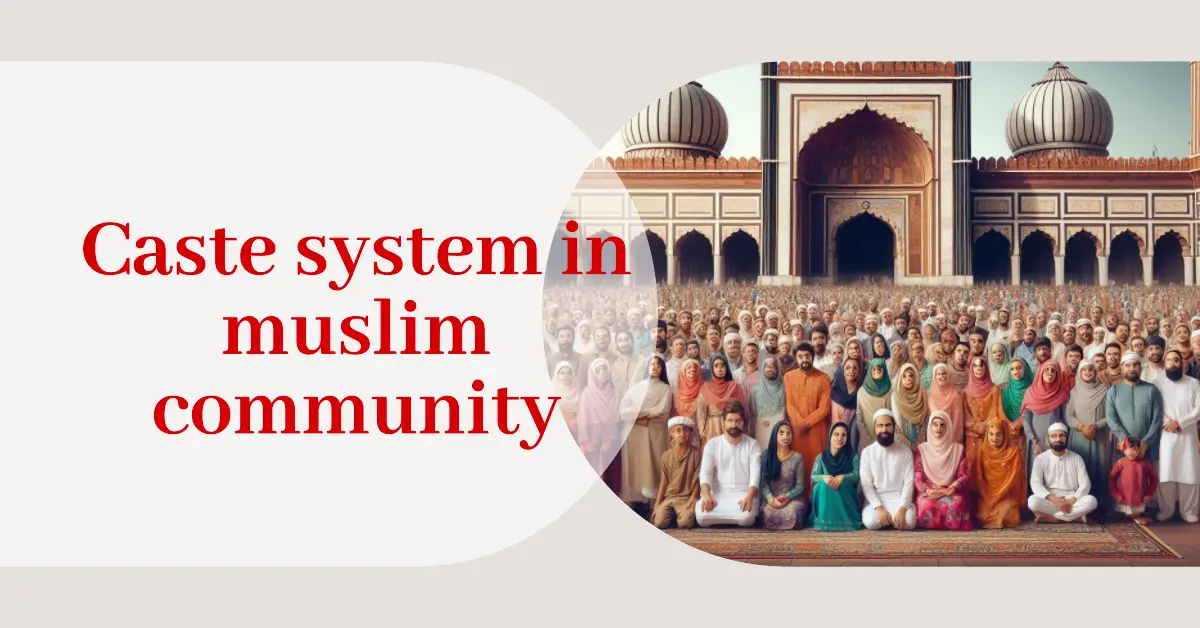In the rich tapestry of Indian society, diversity thrives. This diversity extends to religious communities, and Islam is no exception. While Islam, in theory, unequivocally rejects casteism, the Indian Muslim community presents a paradox – the persistence of caste-based distinctions, which often transcend the theological purity of the faith.
Within the Indian Muslim population, the intricate web of casteism is encapsulated in two broad categories: Pasmanda and Ashraf. These categories are not rooted in Islamic doctrine but have evolved over centuries, shaping the social and economic dynamics of Indian Muslim society.
Pasmanda, largely comprised of those who converted from lower Hindu castes, have often faced historical disadvantage and social marginalization. On the other hand, the Ashraf, composed of Muslims of Arab or Persian origin and converts from higher Hindu castes, have traditionally held positions of influence within the community.
This division based on ancestry and social status has created a complex and sometimes contentious interplay within Indian Islam, challenging the universal brotherhood espoused by the faith.
In this article, we delve into the origins of this caste-based distinction within the Indian Muslim community and the contemporary implications it holds. We explore how these divisions have affected the socio-economic and political realities of Indian Muslims and discuss efforts to challenge and overcome these divisive practices, aligning with the foundational principles of Islam that promote equality and unity among all believers.
The landscape of Indian Islam is enriched by the presence of these various castes, each with its own rich history and cultural tapestry. While the following list is by no means exhaustive, it provides an overview of some of these unique communities:
- Abaaziya
- Abazia
- Afaliyya
- Ahariya
- Ahfatiya
- Ahsamiya Ya
- Aj Abiya
- Ajusiyah
- Akhbasiya
- Ajjadah
- Alilalahiya
- Amalia
- Amariya
- Amaria
- Ansariya
- Arabiyya
- Arshesayani
- Ashan Ashariya
- Ashariya
- Ashrakin
- Asfariya
- Asmariya
- Aswariya
- Azraqiyya
- Bahshiyya
- Bahshisiyah
- Bahshmiya
- Babiya
- Bakharia
- Bashriya
- Bataniya
- Bergosia
- Brahmiya
- Byaniya
- Chishtiya
- Dahriya
- Davadiya
- Farqiya
- Farukiya
- Farqaniya
- Filasfiya
- Furqaniya
- Galiya
- Galat
- Garsanya
- Habatiya
- Haliya
- Hamaosat
- Hajatriya
- Hanafiya
- Hasaniya
- Hasmia
- Hasmia
- Hashtaimamia
- Hazaliya
- Hazatiya
- Hazimiya
- Imamiya
- Ibariya
- Ishaqiya
- Jakhtiya
- Jarudiya
- Jahimiya
- Jafariya
- Kandariya
- Kamliya
- Karamiya
- Kanamiya
- Kanjiyya
- Kharijiya
- Klabia
- Kokbiya
- Malkiyya
- Makramiya
- Makhturia
- Mafazzaliyya
- Mafuziya
- Mabiyya
- Majiya
- Majhuliya
- Mankaniya
- Mansooriya
- Marsiya
- Mawadhiya Wahhabi
- Miquiya
- Mizaiyya
- Motaliyya
- Mujsamiya
- Muhammadiya
- Mukmariya
- Murtazia
- Mustadarikiya
- Mustasiya
- Mushabahiya
- Naferania
- Najdiya
- Najmamuniyya
- Najraat
- Nasariyya
- Nasiriya
- Naqshbandiya
- Navasya
- Newspaper Iyyin
- Now Dia
- Qadriya
- Qasaniya
- Qasmiya
- Qasmiya
- Qataiya
- Rafziyya
- Rakhbiya
- Razaniya
- Rahmaniya
- Salafiya
- Saftya
- Salmiya
- Samhazia
- Samrakhya
- Saminiya
- Sammisya
- Sarafiyya
- Sariyah
- Sarafiyya
- Shaibiya
- Shaitaniya
- Shamsasya
- Shamsasya
- Shamsia
- Shapayya
- Sheikhiyya
- Sobaniya
- Sobeya
- Sopstaiya
- Tabakumiya
- Tabariya
- Tabariya
- Takliya
- Tanasukhya
- Tatiliya
- Unkindness
- Vahmiyya
- Wabariya
- Wazidiya
- Yatraiyah
- Yunaniya
- Zaidiya
- Zaria
- Qarabatiya
- Qasaniya
- Najraat
- Aswariya
- Asfariya
- Najamiya
- Aswariya
- Asfariya
- Najamiya
- Abaaziya
- Ahsamiya Ya
- Bahshisiyah
- Nagaliyyah
- Ajjadah
- Akhwasiya
- Shaibaniyyah
- Makramiya
- Wasliyya
- Hazaliya
- Najamiya
- Aswariya
- Askafia
- Majwaria
- Bashriya
- Asmariya
- Hasamiya
- Saljiyyah
- Habatiya
- Mukmariya
- Samamiya
- Jakhtiya
- Hariba
- Jafariya
- Bahshmiya
- Jabaniya
- Kabayya
- Khyatiya
- Garsanya
- Sobaniya
- Sobeya
- Unkindness
- Bergosia
- Naferania
- Byaniya
- Mughiriya
- Kamliya
- Mansooriya
- Khatabiya
- Aj Abiya
- Jamia
- Mustadarikiya
- Mujsamiya
- Karamiya
- Jahimiya
- Hanafiya
- Malkiyya
- Shapayya
- Hambiliya
- Srifiya
- Davadiya
- Sabaiya
- Mafazzaliyya
- Zaria
- Ishaqiya
- Shaitaniya
- Mafuziya
- Qasaniya
These communities, with their distinct identities and customs, coexist within the broader framework of Indian Islam. While they maintain their unique practices and traditions, there remains a common thread of Islamic faith that unites them all.
This diversity highlights the pluralistic nature of India and underscores the importance of inter-caste and interfaith dialogue to promote understanding and unity.
This list of 214 castes serves as a mere glimpse into the rich tapestry of Indian Muslim diversity. Each community carries its own unique history, traditions, and practices, collectively enriching the multi-faith mosaic of India.
In a nation where unity in diversity is a celebrated norm, the diverse Muslim communities are a testament to the beauty of India’s multicultural fabric.
They underscore that while there is strength in unity, there is also a profound richness in celebrating the unique and distinct aspects of each community’s Islamic identity.


